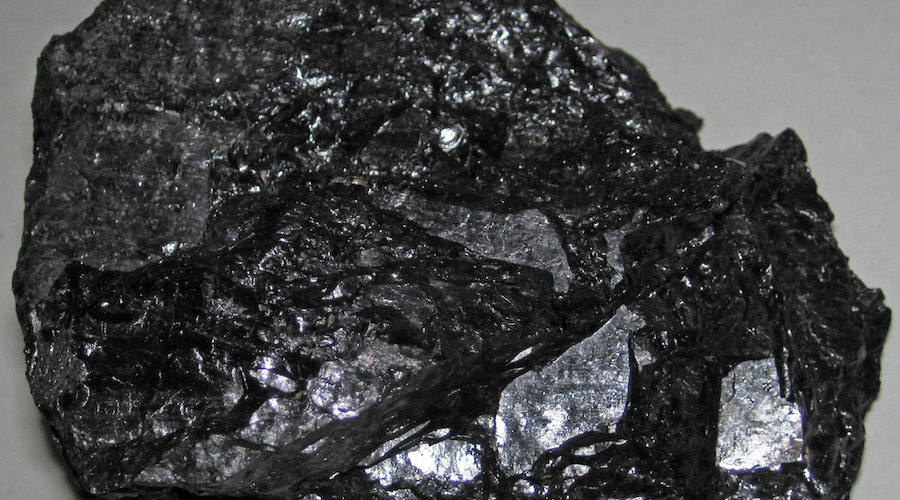Staff Writer | January 8, 2023 |

Coal. (Reference image by James St. John, Flickr.)
A team at Ohio University carried out a series of simulations showing how coal can be converted to valuable—and carbon-neutral—materials like graphite and carbon nanotubes.

Using the Pittsburgh Supercomputing Center’s Bridges-2 system, the researchers simulated coal and graphite in computer software and recreated the coal-to-graphite conversion virtually. Generations of scientists know that, at least in theory, it is possible to convert coal to graphite if the fossil fuel is put under enough pressure at a high enough temperature.
Pure graphite is a series of sheets made up of six-carbon rings. A special type of chemical bond called ‘aromatic bond’ holds these carbons together.
In aromatic bonds, pi electrons float above and below the rings. These “slippery” electron clouds cause the sheets to slide easily past each other. Pencil “lead”—a low-grade form of graphite—leaves a mark on paper because the sheets slip off of each other and stick to the paper.
Aromatic bonds have another virtue, important in electronic technology. The pi electrons move easily from ring to ring and sheet to sheet. This makes graphite conduct electricity, even though it is not a metal.
Coal, by comparison, is messy chemically. Unlike the strictly two-dimensional nature of a graphite sheet, it has connections in three dimensions. It also contains hydrogen, oxygen, nitrogen, sulphur, and other atoms that might disrupt graphite formation.
Simplified coal
To begin their studies, David Drabold and his team created a simplified “coal” that consisted of only carbon atoms in random positions. By exposing this simplified coal to pressure and high temperature—about 3,000 Kelvin, or nearly 5,000 Fahrenheit—they could take a first step in studying its conversion to graphite.
“To push out the amorphous-graphite paper we needed to do a lot of serious analysis,” said Chinonso Ugwumadu, a doctoral student in Drabold’s group. “Compared to other systems which we have, Bridges is the fastest and most accurate. Our home systems … take about two weeks to simulate 160 atoms. With Bridges, we can run 400 atoms over six to seven days using density functional theory.”
At first, the Ohio scientists carried out their simulations using basic physical and chemical principles via density functional theory. This accurate but calculation-heavy approach required many parallel computations. Later, they shifted their calculations to a new software tool, GAP (Gaussian approximation potential), which uses machine learning to carry out essentially the same computations much more quickly.
Their results were more complicated than the team had expected. The sheets did form. But the carbon atoms didn’t entirely develop simple, six-carbon rings. A fraction of the rings had five carbons; others had seven.
The non-six-carbon rings posed an interesting wrinkle, in more ways than one. While six-carbon rings are flat, five- and seven-membered carbon rings pucker, but in opposite senses of “positive and negative curvature.”
The scientists might have expected these puckers to ruin the formation of the graphite sheets. But sheets formed anyway, possibly because pentagons and heptagons balanced each other in the simulations. The sheets were technically amorphous graphite because they weren’t purely six-ringed. But again, they formed layers.
Carbon nanotubes
In another series of simulations, Ugwumadu followed up on his work with Rajendra Thapa to study molecules rather than solids. The conditions in these sims caused the sheets to curve in on themselves. Instead of sheets, they formed nested amorphous carbon nanotubes (CNTs)—a series of single-atomic-layer tubes, one inside another.
CNTs have been hot in materials science lately, as they are in effect tiny wires that can be used to conduct electricity at incredibly small scales. Other promising applications of CNTs include fuel cell catalysis, the production of supercapacitors and lithium-ion batteries, electromagnetic interference shielding, biomedical sciences, and nano-neuroscience.
One important facet of the CNT work was that Ugwumadu studied how amorphous wrinkles in the tube walls affect the movement of electricity through the structure. In materials science, every “bug” is also a “feature”—engineers may be able to use such irregularities to tune the behaviour of a given CNT to match the exact requirements needed in a new electronic device.
The group continues to study the conversion of carbon atoms to graphite and related materials.
No comments:
Post a Comment